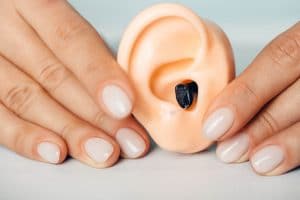Hearing aids are a major investment, and you’ll want to get the most out of them that you can.
Regular maintenance can help extend their life, and is a must considering the conditions they are exposed to on a regular basis. Moisture, heat, earwax and dirt can all damage electronic components unless cleaned properly.
Routine Maintenance for Hearing Aids

Ideally, your hearing aids should be cleaned daily.
Use a soft, dry cloth to gently wipe all surfaces.
Do not use water, solvents, cleaning fluids or alcohol, as moisture can damage your devices.
Don’t overlook the microphone inlet, which can become clogged with debris, and the battery contacts, which attract dust and dirt.
Most hearing health care providers sell a multi-tool, a versatile cleaning tool that consists of a wire loop, magnet and brush. This is useful for removing wax and dirt from hard-to-reach nooks and crannies in your hearing aids, and the magnet aids in battery removal. If a multi-tool is not available, you can usually buy each component separately.
Be sure to apply hairspray and facial lotions before inserting your hearing aids. The same applies to face washing.
Troubleshoot your hearing device
Despite your best efforts, your hearing aids might still cease functioning normally on occasion. Before taking them in for repair, there are steps you can take at home that might resolve the problem.
- If there is feedback or whistling when your hearing aids are inserted, the devices might have been inserted improperly. Try removing and reinserting to see if that solves the problem. If not, earwax might have accumulated and clogged the ports; clean them thoroughly with your multi-tool or wax pick.
- If the sound is distorted or unclear, your battery or contacts might be dirty or corroded. Try cleaning the battery surfaces or replacing the battery. Sometimes merely opening and closing the battery compartment door will help. Make sure your device hasn’t inadvertently been switched to T-coil mode.
- If there is no sound at all, make sure the battery isn’t dead. Check for a clogged microphone or sound outlet, or try changing the wax filter.
If these tips do not solve your problem, you’ll have to take your hearing aids in for repair. Cost will depend on what is damaged, which replacement parts are needed and whether your device is still under warranty.